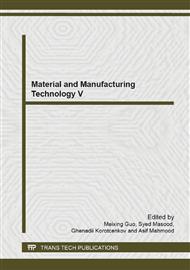p.373
p.379
p.384
p.389
p.394
p.398
p.402
p.408
p.413
Determination of Bore Grinding Machine Parameters to Reduce Cycle Time
Abstract:
This paper applies a central composite design (CCD) to determine proper machine parameters to reduce the cycle time of a bore grinding process. There are 6 machine parameters, which are rough grinding 2 starting position, fine grinding starting position, speed of rough grinding 1, speed of rough grinding 2, speed of rough grinding 3 and speed of fine grinding and 2 types of responses, which are cycle time and surface roughness considered in this study. A half CCD is used to find the optimal machine setup parameters. The experiment shows that new machine conditions can reduce cycle time from 2.98 second per piece to 2.76 second per piece and control surface roughness within specification of 1.0 um. After implementing the new machine conditions in the real setting, we found that the average actual cycle time is 2.76 second per piece with roughness of 0.841 um.
Info:
Periodical:
Pages:
413-417
Citation:
Online since:
June 2014
Price:
Сopyright:
© 2014 Trans Tech Publications Ltd. All Rights Reserved
Share:
Citation:


